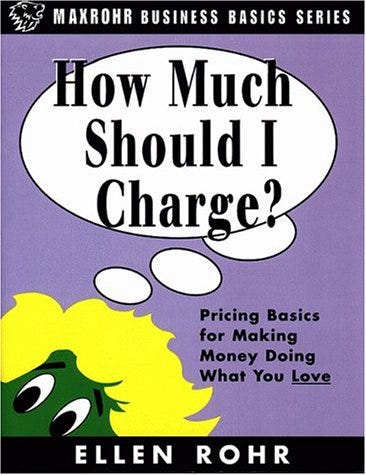When I knew I was going to work for myself, I knew one of the first questions I needed to answer was:
(according to Amazon, I originally bought this book just five months before I officially started, good job Past Garrick).
Rohr walks you through what your lifestyle costs (food, rent, utilities, phone, car, gas, retirement, savings, etc, etc) and all your new non-obvious business costs (e.g. supplies, licenses, self-employment taxes, marketing, sales taxes, taxes, and taxes), then totals them up, divides them around, and helps you declare a minimum price your services.
I’ve since become an advocate for value-based pricing for all kinds of reasons, but that’s a more advanced topic for another day.
The point of the book, the point the exercise, and the point of this email is to price your services in a way that at least pays for lifestyle. I still remember giving myself sticker shock when I saw the final number. I recall many examples in the book of new business owners having the same reaction. Recently, my wife walked a friend through this exercise and yep, self-sticker-shock.
Part of the problem is that so much of our consumer world isn’t priced in a straight-forward manner; promotions, discounts, subsidies, loss-leaders - all kinds of justifications to drive down prices to encourage more purchases.
Another part of the problem is 14 years of ZIRP and a ‘one company to return the entire fund’ VC strategy of portfolio management has made the consumer internet the absolute worst for pricing. Though, we as consumers have accumulated a massive economic surplus from these strategies ($204/yr for my entire family to have on-demand access to nearly every song ever - that’s an absurd level of abundance).
However, it doesn’t provide new founders with guidance on what cover-your-lifestyle pricing looks like out of the gate.
In my work with founders, I do a gut check by comparing their current pricing against:
($200,000/year/founding team member) / (current transaction price) = # of annual transactions required to pay for their lifestyle
And I ask myself, does the team seem on-track to make that many transactions this year?
Is that number of transactions even achievable (e.g. Addressable Market)?
It’s not unusual for the transaction number to be in the thousands or tens of thousands. And this is a problem. Again, this is often the first time founders have looked at their business this way. I know this because I asked them and they say things like, ‘No, we’ve never calculated pricing based on supporting our lifestyle’. Even venture-backed startups that have already navigated cap tables and set up boards of directors.
So, what does this look like in reality?
Let’s say, you and I are starting a new company that uses AI to teach people to play kubb at an elite level - where they could win US Nationals. We think the market will bear $25/week. Does the math pencil out?
($200,000 * 2) = $400,000 / 25 = 16,000 transactions.
Um. Crap. That’s too many transactions. It’ll take a while to build up to that number, we’ll probably need to buy advertising which will add to our expenses. Ugh.
OK, wait, we’ll sell 6-month, 26-week, subscriptions, Jan-Jun just in time for Nationals….
($200,000 * 2) = $400,000 / (25*26) = 615 transactions.
Argh. I know a lot of enthusiastic kubb players that want to improve, but I don’t think know 615.
What if I went it alone and only wanted to cover my lifestyle for those first six months:
$100,000 / (25*26) = 153 transactions.
Hmmm. Getting closer. Nationals is 3-person teams, could we find 51 teams that would pay $650 for AI training. Maaaaaaybe.
What if we switched to a B2B offering (something like a - corporate off-site team building tournament thingy), the math immediately changes:
($200,000 * 2) = $400,000 / $10,000 = 40 transactions.
Oh. Interesting. Now we’re getting somewhere. Could you and I brainstorm 40 organizations that could buy our kubb team-building package for their corporate offsite?
Yes, easy. We could probably brainstorm more than that. Sure, we’d still have to sell about 1 per week to make this work (again, difficult but approachable), especially if there’s two of us. **high five**
Why $10,000? This is where my B2B pricing rule comes in:
In my experience, this floor is most often $10,000.
Sometimes, it’s higher.
Sometimes it’s much higher.
The point is, we don’t need highly-exact numbers to figure out pricing that will cover our costs and support our lifestyles. Rough numbers will shock us into reality just as well.





